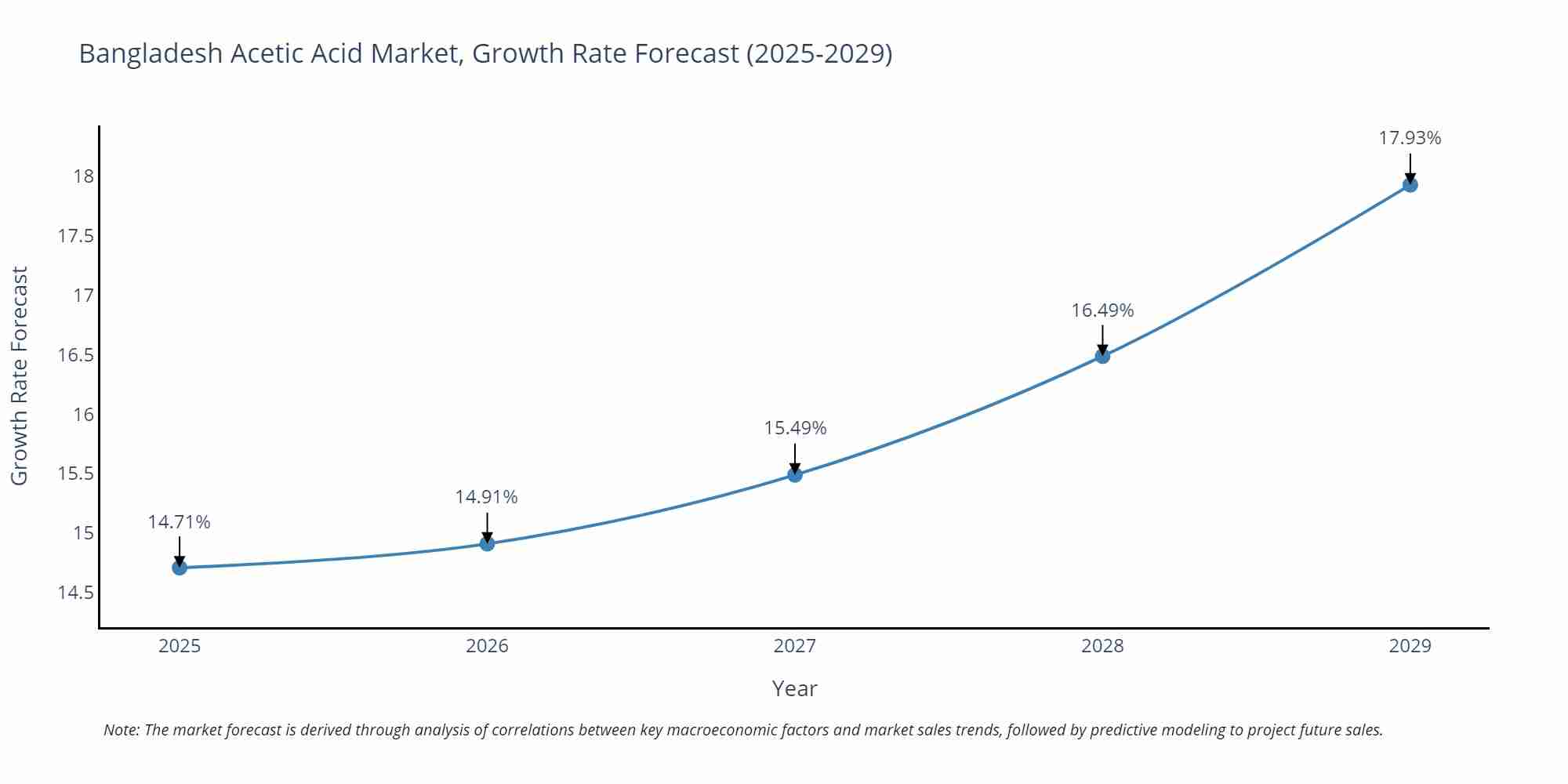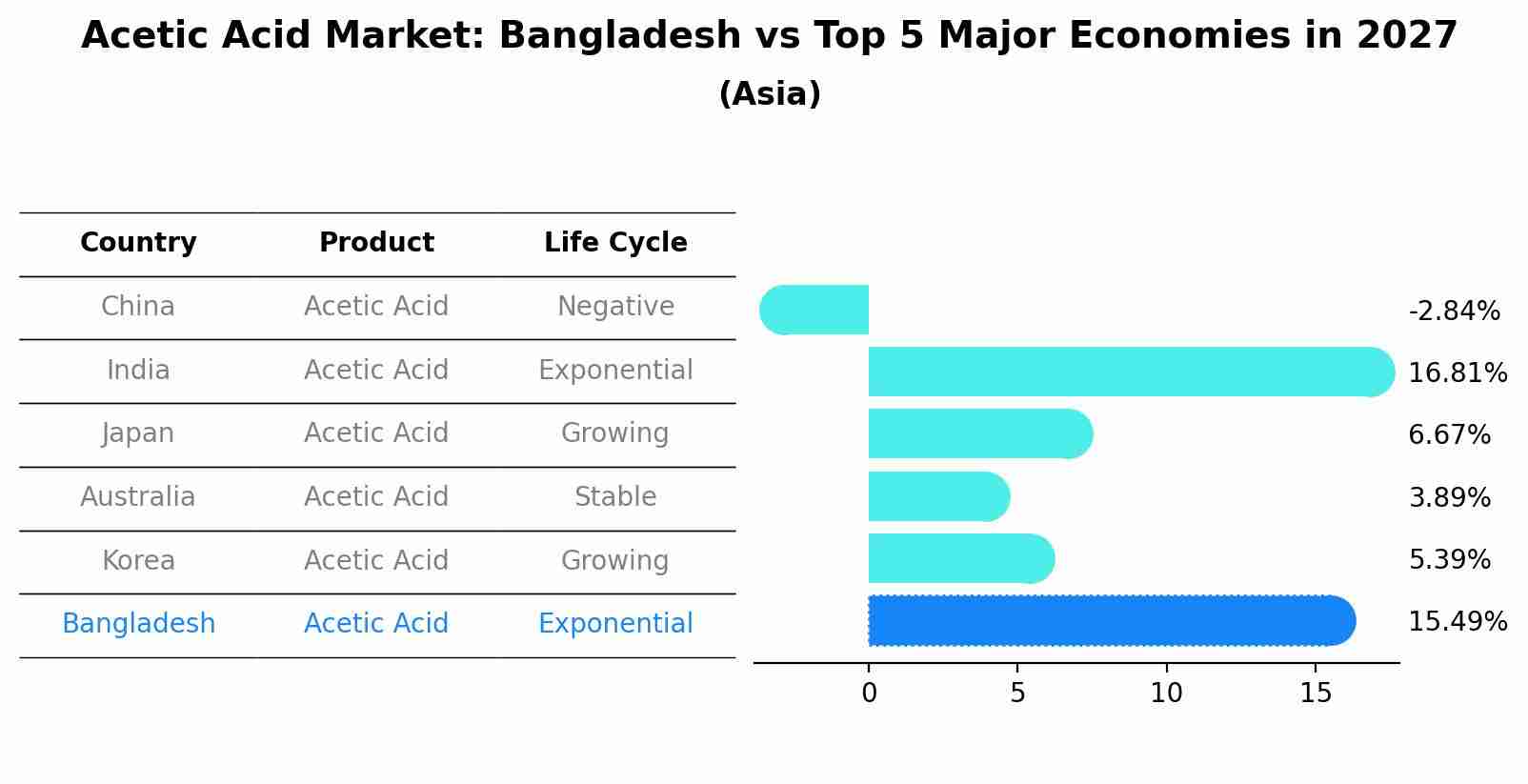Bangladesh Acetic Acid Market (2025-2031) Outlook | Value, Companies, Growth, Trends, Analysis, Share, Industry, Revenue, Size & Forecast
| Product Code: ETC411748 | Publication Date: Oct 2022 | Updated Date: Jul 2025 | Product Type: Market Research Report | |
| Publisher: 6Wresearch | Author: Ravi Bhandari | No. of Pages: 75 | No. of Figures: 35 | No. of Tables: 20 |
Bangladesh Acetic Acid Market Size Growth Rate
The Bangladesh Acetic Acid Market is likely to experience consistent growth rate gains over the period 2025 to 2029. The growth rate starts at 14.71% in 2025 and reaches 17.93% by 2029.

Acetic Acid Market: Bangladesh vs Top 5 Major Economies in 2027 (Asia)
In the Asia region, the Acetic Acid market in Bangladesh is projected to expand at a exponential growth rate of 15.49% by 2027. The largest economy is China, followed by India, Japan, Australia and South Korea.

Bangladesh Acetic Acid Market Synopsis
The Bangladesh Acetic Acid market is experiencing steady growth driven by factors such as increasing industrial applications in textiles, pharmaceuticals, and food processing industries. The country`s growing manufacturing sector and rising demand for chemicals contribute to the market expansion. Local manufacturers and imports cater to the market needs, with key players including Square Pharmaceuticals Ltd., Samuda Chemical Complex Ltd., and BASF Bangladesh Ltd. The market is also influenced by global price fluctuations of raw materials like methanol and natural gas. Regulatory factors and environmental considerations play a crucial role in shaping market dynamics. With ongoing industrial developments and a favorable business environment, the Bangladesh Acetic Acid market is expected to maintain its growth trajectory in the coming years.
Bangladesh Acetic Acid Market Trends
The Bangladesh Acetic Acid market is currently witnessing steady growth driven by increasing demand from various industries such as textiles, food & beverages, and pharmaceuticals. The textile industry, in particular, is a major consumer of acetic acid for use in dyeing and finishing processes. Additionally, the food & beverage sector is also contributing to the market growth due to the use of acetic acid as a preservative and flavoring agent. The pharmaceutical industry is another key driver, utilizing acetic acid in the production of various medications. With a growing economy and increasing industrial activities, the demand for acetic acid in Bangladesh is expected to continue on an upward trajectory in the coming years, presenting opportunities for market players to expand their presence and offerings in the region.
Bangladesh Acetic Acid Market Challenges
The Bangladesh acetic acid market faces several challenges, including fluctuating raw material prices, limited domestic production capacity, and competition from cheaper imports. The market heavily relies on imported acetic acid due to insufficient local production, making it vulnerable to global price fluctuations and supply chain disruptions. Additionally, the presence of counterfeit products in the market poses a threat to the reputation of genuine acetic acid suppliers. Regulatory hurdles and compliance requirements also add complexity to the market environment. To remain competitive and sustainable, companies in the Bangladesh acetic acid market need to address these challenges by enhancing production capacity, improving supply chain resilience, ensuring quality control measures, and implementing effective market strategies.
Bangladesh Acetic Acid Market Investment Opportunities
The Bangladesh Acetic Acid Market presents promising investment opportunities due to the country`s growing chemical industry and increasing demand for acetic acid in various applications such as textiles, pharmaceuticals, and food processing. With a strong focus on industrial development and infrastructure projects, there is a rising need for acetic acid as a key chemical ingredient. Investors can explore opportunities in establishing manufacturing facilities for acetic acid production or investing in existing manufacturers to expand their production capacity. Additionally, partnerships with local distributors and suppliers can provide a strategic advantage in accessing the market efficiently. With supportive government policies and a favorable business environment, the Bangladesh Acetic Acid Market offers potential for profitable investments and long-term growth.
Jordan Agar Market Government Policies
The government of Bangladesh has implemented various policies related to the acetic acid market to ensure sustainability and growth. These policies include import restrictions and tariffs to protect local manufacturers, quality control standards to ensure the safety of products, and incentives for investment in the sector to promote domestic production. Additionally, the government has set up regulatory bodies to monitor and regulate the acetic acid market to prevent price manipulation and ensure fair competition. Overall, these policies aim to support the growth of the acetic acid industry in Bangladesh while safeguarding the interests of local producers and consumers.
Bangladesh Acetic Acid Market Future Outlook
The future outlook for the Bangladesh Acetic Acid market appears promising, with steady growth expected in the coming years. Factors driving this growth include increasing industrial applications of acetic acid in sectors such as textiles, pharmaceuticals, and chemicals, as well as the expanding food and beverage industry. The country`s growing population and rising disposable incomes are also likely to fuel demand for acetic acid-based products. Additionally, government initiatives to attract foreign investment and promote industrial development are expected to further boost the market. However, challenges such as fluctuating raw material prices and environmental regulations may impact market dynamics. Overall, the Bangladesh Acetic Acid market is anticipated to experience sustained growth, offering opportunities for both domestic and international players in the industry.
Key Highlights of the Report:
- Bangladesh Acetic Acid Market Outlook
- Market Size of Bangladesh Acetic Acid Market, 2024
- Forecast of Bangladesh Acetic Acid Market, 2031
- Historical Data and Forecast of Bangladesh Acetic Acid Revenues & Volume for the Period 2021 - 2031
- Bangladesh Acetic Acid Market Trend Evolution
- Bangladesh Acetic Acid Market Drivers and Challenges
- Bangladesh Acetic Acid Price Trends
- Bangladesh Acetic Acid Porter's Five Forces
- Bangladesh Acetic Acid Industry Life Cycle
- Historical Data and Forecast of Bangladesh Acetic Acid Market Revenues & Volume By Application for the Period 2021 - 2031
- Historical Data and Forecast of Bangladesh Acetic Acid Market Revenues & Volume By Vinyl Acetate Monomer for the Period 2021 - 2031
- Historical Data and Forecast of Bangladesh Acetic Acid Market Revenues & Volume By Acetic Anhydride for the Period 2021 - 2031
- Historical Data and Forecast of Bangladesh Acetic Acid Market Revenues & Volume By Acetate Esters for the Period 2021 - 2031
- Historical Data and Forecast of Bangladesh Acetic Acid Market Revenues & Volume By Purified Terephthalic Acid for the Period 2021 - 2031
- Historical Data and Forecast of Bangladesh Acetic Acid Market Revenues & Volume By Ethanol for the Period 2021 - 2031
- Historical Data and Forecast of Bangladesh Acetic Acid Market Revenues & Volume By Others for the Period 2021 - 2031
- Bangladesh Acetic Acid Import Export Trade Statistics
- Market Opportunity Assessment By Application
- Bangladesh Acetic Acid Top Companies Market Share
- Bangladesh Acetic Acid Competitive Benchmarking By Technical and Operational Parameters
- Bangladesh Acetic Acid Company Profiles
- Bangladesh Acetic Acid Key Strategic Recommendations
Frequently Asked Questions About the Market Study (FAQs):
- Single User License$ 1,995
- Department License$ 2,400
- Site License$ 3,120
- Global License$ 3,795
Search
Thought Leadership and Analyst Meet
Our Clients
Related Reports
- Canada Oil and Gas Market (2026-2032) | Share, Segmentation, Value, Industry, Trends, Forecast, Analysis, Size & Revenue, Growth, Competitive Landscape, Outlook, Companies
- Germany Breakfast Food Market (2026-2032) | Industry, Share, Growth, Size, Companies, Value, Analysis, Revenue, Trends, Forecast & Outlook
- Australia Briquette Market (2025-2031) | Growth, Size, Revenue, Forecast, Analysis, Trends, Value, Share, Industry & Companies
- Vietnam System Integrator Market (2025-2031) | Size, Companies, Analysis, Industry, Value, Forecast, Growth, Trends, Revenue & Share
- ASEAN and Thailand Brain Health Supplements Market (2025-2031) | Strategy, Consumer Insights, Analysis, Investment Trends, Opportunities, Growth, Size, Share, Industry, Revenue, Segments, Value, Segmentation, Supply, Forecast, Restraints, Outlook, Competition, Drivers, Trends, Demand, Pricing Analysis, Competitive, Strategic Insights, Companies, Challenges
- ASEAN Bearings Market (2025-2031) | Strategy, Consumer Insights, Analysis, Investment Trends, Opportunities, Growth, Size, Share, Industry, Revenue, Segments, Value, Segmentation, Supply, Forecast, Restraints, Outlook, Competition, Drivers, Trends, Demand, Pricing Analysis, Competitive, Strategic Insights, Companies, Challenges
- Europe Flooring Market (2025-2031) | Outlook, Share, Industry, Trends, Forecast, Companies, Revenue, Size, Analysis, Growth & Value
- Saudi Arabia Manlift Market (2025-2031) | Outlook, Size, Growth, Trends, Companies, Industry, Revenue, Value, Share, Forecast & Analysis
- Uganda Excavator, Crane, and Wheel Loaders Market (2025-2031) | Strategy, Consumer Insights, Analysis, Investment Trends, Opportunities, Growth, Size, Share, Industry, Revenue, Segments, Value, Segmentation, Supply, Forecast, Restraints, Outlook, Competition, Drivers, Trends, Demand, Pricing Analysis, Competitive, Strategic Insights, Companies, Challenges
- Rwanda Excavator, Crane, and Wheel Loaders Market (2025-2031) | Strategy, Consumer Insights, Analysis, Investment Trends, Opportunities, Growth, Size, Share, Industry, Revenue, Segments, Value, Segmentation, Supply, Forecast, Restraints, Outlook, Competition, Drivers, Trends, Demand, Pricing Analysis, Competitive, Strategic Insights, Companies, Challenges
Industry Events and Analyst Meet
Whitepaper
- Middle East & Africa Commercial Security Market Click here to view more.
- Middle East & Africa Fire Safety Systems & Equipment Market Click here to view more.
- GCC Drone Market Click here to view more.
- Middle East Lighting Fixture Market Click here to view more.
- GCC Physical & Perimeter Security Market Click here to view more.
6WResearch In News
- Doha a strategic location for EV manufacturing hub: IPA Qatar
- Demand for luxury TVs surging in the GCC, says Samsung
- Empowering Growth: The Thriving Journey of Bangladesh’s Cable Industry
- Demand for luxury TVs surging in the GCC, says Samsung
- Video call with a traditional healer? Once unthinkable, it’s now common in South Africa
- Intelligent Buildings To Smooth GCC’s Path To Net Zero


















